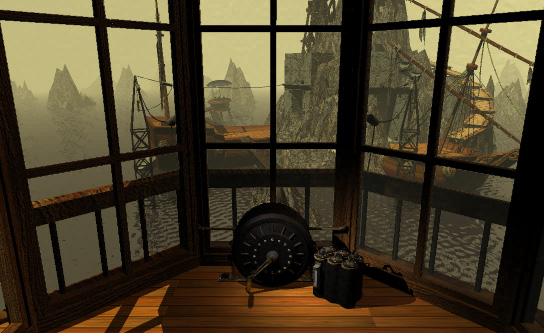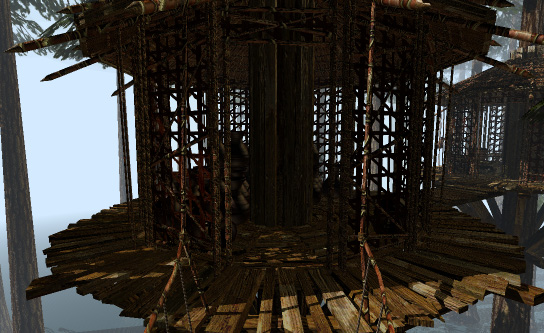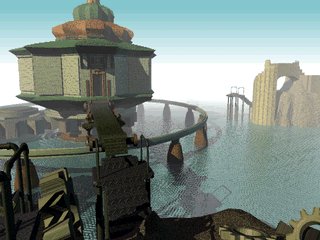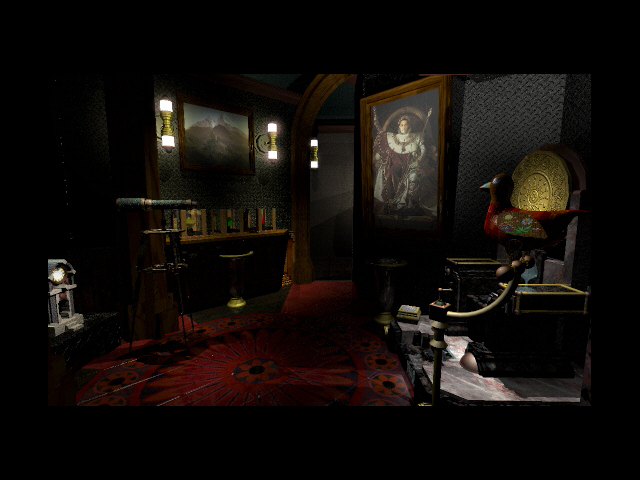
http://www.cybertown.com/hilf.html
October 1993, Robyn and Rand Miller, the designers Myst, had encountered a similar landslide success. They attribute the attraction of Myst to “the same nebulous thing that attracts people to a good book or a good movie.” The game is a first-person perspective of an uninhabited island world. As Robyn Miller explains, “It is an experience that you keep revisiting”; an idea described in the slogan under the title, which reads: “The Surrealistic Adventure That Will Become Your World.” Through text and clues discovered along the way, the user can piece together Myst’s storyline to learn what happened on the island. Unlike the majority of other interactive games on the market at the time of Myst’s release, the user cannot die within the game. This allows the user to enter and leave the game at his or her convenience, without having to start over, or play against the clock. Myst generates a complex storyline from a limited number of facts, thus drawing the user into the narrative much like a reader is drawn into a mystery novel. In addition, the visual interaction is smooth, and the game is embedded with ambient sounds and subtextual plots. In this aspect, Myst proved to be enjoyable, and marketable, to both children and adults.
This paper is part of a longer work titled: “Digital Entertainment: Art, Technology, and The New Forms of Storytelling in the Digital Era.”
http://gamespot.com/gamespot/features/pc/most_influential/p14.html
Myst Developer: Cyan Productions Publisher: Broderbund Year: 1993
Critics and game players have debated, fought over, loved, and dismissed Myst over the years, but it is undeniably one of the most influential games of all time. Myst revitalized a stagnant PC games market and, with games like Doom, helped to bring popular attention to gaming more than any other game in computer-gaming history. As such, it became a milestone and remains a model for success. In fact, more than 6.3 million copies have been sold since its release in 1993 (or over 4.3 million in US sales according to PC Data). Myst was a cultural phenomenon in 1993 and represents the kind of success that many game developers have tried to duplicate.
When Myst appeared, its graphics immediately impressed people. Water was crystal-clear, trees seemed alive, indoor settings were opulently decorated, and objects looked quite realistic, thanks to fine textures, nuanced shading, and specular and diffuse reflections. The press and gamers alike praised Myst's visuals, often showering them with the accolades "groundbreaking" and "stunning." Indeed, Myst's graphics were beautiful and reflected a cohesive design that was intended to immerse you fully into the gameworld. The game did do a remarkable job convincing you that this alternate reality existed, and that your travels through four ages, each with a distinct motif, constituted a real adventure. Though you couldn't rotate freely in 360 degrees or move in real time (Myst was built on Apple's simple image-flipping HyperCard application), you still felt immersed in an another world. Myst completely contrasted with the simple graphics of other adventure games, and it demonstrated the potential for the multimedia graphic adventure genre.
Myst's gameplay was also a departure from that of the traditional adventure game. While adventure games typically meant that you would interact with characters and an environment, Myst shifted the focus uniquely to the environment. You had no inventory, no persona, and no dialogue; you didn't even have a name. You were also completely alone in this world; no other characters were there to help guide you, except for the brief QuickTime video appearances of the story's main characters. However, you could walk around the landscape; you could walk up to an object lying on the ground or on the floor; you could approach an object and interact with it by flipping its switches or rotating its dials to solve a puzzle. In fact, much of the nonlinear gameplay and progression of the story were mysterious and left up to the players to figure out. As such, no one really played Myst so much as experienced it.
To put the game in context, Myst belonged to the first generation of big CD-ROM games. These multimedia-rich games were the rage in the early 1990s. Trilobyte's The Seventh Guest was really the first one, and from a technological standpoint, Myst didn't really match it. But Myst was incredibly good at pushing existing technology to its limits: CD-ROM drives were slow, so the image transitions in Myst occurred slowly, even agonizingly so. But players didn't want to go back once they had gotten a taste for such visually stunning graphics. Consumers even upgraded their computers to have better, faster CD-ROM drives to play these CD-ROM-based games. And Myst was the CD-ROM game that everyone wanted to play. This marked a key point at which adventure games were some of the most crowd-pleasing games in the industry. Games such as Zork Nemesis, Obsidian, Amber, Nemesis: The Wizardry Adventure, Riven, and more all part of Myst's legacy.
http://www.gamespot.com/pc/adventure/myst/index.html
screenshots!http://myst.cafe24.com/gallery/g_myst.htm
more screenshots
























